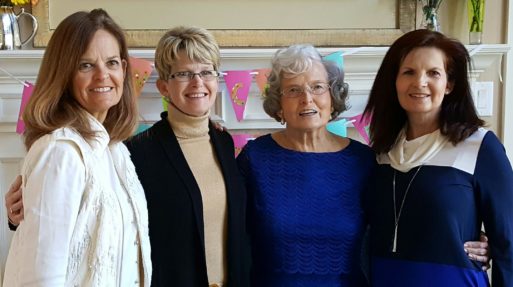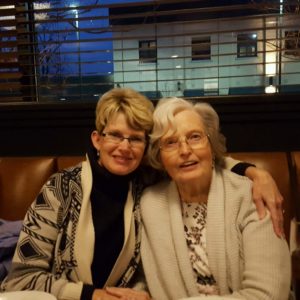This is the story of Melissa as told by her. Our “Opening Our Hearts” stories are based on people’s real-life experiences. By sharing these experiences publicly, we hope to help our readers feel less alone in their grief and, ultimately, to aid them in their healing process. In this post, Melissa tells the story of her mother, Molly, her battle with heart failure and kidney disease and the difficult task of sorting through her clothing with her sisters after Molly died.

Melanie, Melissa and Michele with their mother, Molly
Mother’s closet loomed large, one more mountain we had to conquer. The three daughters of Molly Johnson stood motionless, stunned by the reality of what we were about to do, this sad but necessary chore required of those who loved her most.
It’s not that we were surprised by her death. She had been in declining health, and we had seen the ravages of falls, infections, and hospital stays. Each of us had taken her to doctor’s appointments and understood the diagnosis of congestive heart failure and chronic kidney disease. No. We knew our 86-year-old mother was near the end of her life. What we didn’t know was how physically painful death could be.
Perhaps we thought all death was a quiet kind of passing, the slip into eternal sleep that my grandmother performed after breaking her hip. Or that, like Daddy, the end would come in a final chest rattle three days after a massive stroke. Maybe we had latched onto a romanticized idea of an angel swooping down to deftly lift Mother as she slept, stealing her away like an escaped sigh.
It wasn’t like that it all.
Mother suffered. Her pain was horrible. For the last three days of her life, every few minutes she would moan, “Help me!” No matter what the hospice nurses tried — frequent increases of morphine doses, different positions in the bed, gentle massage, ice chips on her lips — nothing appeased her pain. No matter what her daughters said or did, nothing soothed her mind and body. Our stoic mother who never complained about anything during her life was in agony each step of her journey to death.
We were still a little angry at God, bewildered by the amount of pain in our mother’s passing. Still sore from grief, fatigue, and the frenzy of planning a funeral, my sisters and I stood shoulder to shoulder gaining strength from each other. We forged ahead. It’s what we were taught to do.
 The tiny space allocated as a closet wasn’t nearly big enough for everything my fashion-conscious mother had brought with her to assisted living. Never flashy, Mother was a quiet kind of attractive with a love of fashion and a taste for the classic. Her very essence floated, hanger by hanger, in front of us. Tops that smelled like her. Coats that had warmed her for years.
The tiny space allocated as a closet wasn’t nearly big enough for everything my fashion-conscious mother had brought with her to assisted living. Never flashy, Mother was a quiet kind of attractive with a love of fashion and a taste for the classic. Her very essence floated, hanger by hanger, in front of us. Tops that smelled like her. Coats that had warmed her for years.
Every garment was connected to a memory. The white tunic trimmed in navy and coral she had worn the last time she was able to go out to lunch with me. The red wool blazer that she always wore to Indiana University games. Her zip-front purple bathrobe worn so many nights in front of the fireplace.
Dozens of shoes in all styles and colors dating back to the 1960s were neatly labeled and stacked in their original boxes. From the “Spectator pumps” Mother loved, to the woven leather Huaraches new in the box, Mother’s shoe obsession was on full display. Heels. Sandals. Slippers. Slides. Wedges. All in triple AAA width. In a place of honor, sitting atop a step stool, Mother had put her worn, white nursing shoes, the symbol of a profession passionately pursued for more than 40 years.
Her wardrobe awaited us, the last tangible link to her soul.
Without warning, an olfactory memory wafted into my brain as I stood teary-eyed in front of Mother’s closet. I swear I could smell the heady gardenia perfume Mother wore when I was a little girl. A scene from the movie Hope Floats plastered itself across my thoughts. When Birdee Pruitt’s (Sandra Bullock) zany Mother has a massive stroke and dies instantly, Birdee acknowledges her loss by stepping into her mother’s closet. She pulls out her mom’s black dress, presses it to her face, and inhales the scent of the woman she loves. Sobbing, she dons the dress and wears it with panache to the funeral. Birdee finds comfort in the emotional residue left in that classic black sheath worn by her deceased mother.
Now my sisters and I had to decide. Would we wear our dead mother’s clothes?

Melissa wearing her
mother’s dress
Several years ago, Mother had “outgrown” a dress I had always liked. It was a classic style in a knock-out fabric. “Missi, take this,” she insisted as she held out a dress bursting with orange poppies and turquoise paisley. Not wanting to hurt her feelings, I accepted reluctantly. Would I really wear the same dress that my eighty-year-old Mother had worn?
Every time I wear that dress people exclaim, “Wow! I love your dress!” Why had I doubted?
The knowledge that Mother’s clothes sometimes worked on me didn’t make cleaning out her closet any easier.
The clock in the tiny bedroom ticked loudly, reminding us that time would not stand still. The inevitable had come.
We divvied up our sweet mother’s clothes.
My younger sister, Michele, is a brilliant, articulate, passionate lawyer who lived closest to Mother and stopped by every night to check on her. When Mother could no longer shop for herself, Michele (herself a fashionista) had often purchased new clothes to fit Mother’s changing needs. That day, Michele’s usual vibrancy and bubbling wit were submerged, crushed under the weight of sadness. She watched as Melanie held up garment after garment, a memory attached like a concrete block to each piece. “Would either of you like this one?” Melanie gently asked.
“It would make me too sad.” Michele’s chin quivered as she looked at the blouse lofted in front of us. “It would make me miss her even more.”
Melanie paused and said, “I like it, but I would never wear it.” Melanie, the oldest of us, is a compassionate, energetic woman with totally different coloring from Mother’s. Where Mother was pale and gray-eyed, Melanie was tanned and brown-eyed with a totally different sense of style. No matter how much she loved her, Melanie wouldn’t look right in Mother’s clothes.
But me, I liked Mother’s style. My coloring is similar, and my eyes are the same gray-blue. Pause after pause, when Melanie held up a piece of Mother’s clothing and neither of my sisters claimed it, I heard myself saying “I’ll take it.”
Pause after pause, when Melanie held up a piece of Mother’s clothing and neither of my sisters claimed it, I heard myself saying “I’ll take it.”
An armload of Mother’s clothes came home with me. (Sadly, like a false Cinderella, I couldn’t shove my slightly bigger foot into those 5-l/2 Narrows.) I claimed her clothes, not because I would wear them all but because I couldn’t stand to see the essence of Mother go to charity grabs where someone would snatch up a piece she had loved for a quarter. No stranger would understand how much our mother valued her clothing. No bargain shopper would grieve for the person whose body had once given that garment life.
I would.
I would flaunt her fashion, wear her proudly, and stay close to her for a little while longer.
This summer, I wore one of my mother’s tops to a ball game where my own daughter said, “Mom. That’s a cute top!” Most of Mother’s other clothes, though, I’m remaking and repurposing, throwing them into an alternative existence by combining her taste with my quirks in an old-but-new-art-to-wear garment.
Sometimes, like Michele said, seeing Mother’s clothes hanging next to mine makes me a little sad. But most of the time, I find comfort in their colors, their contours, and their embedded memories of Mother. Now and then, I catch te faintest whiff of gardenia lingering in the corners of my closet.
SevenPonds is always interested in sharing our readers’ experiences with death, loss and grief. If you have a story that you would like to share, please send us a brief summary of your experience in an email to wecare@sevenponds.com. If your story meets our criteria, we will assign a writer to work with you to create a story for our magazine. Or if you have a finished article you would like to submit, our editor-in-chief will review it and get back to you about next steps.

 My Mother’s Closet
My Mother’s Closet



 Composting Bodies Is Now Legal in a Dozen States
Composting Bodies Is Now Legal in a Dozen States
 “Hand to Earth” by Andy Goldsworthy
“Hand to Earth” by Andy Goldsworthy














